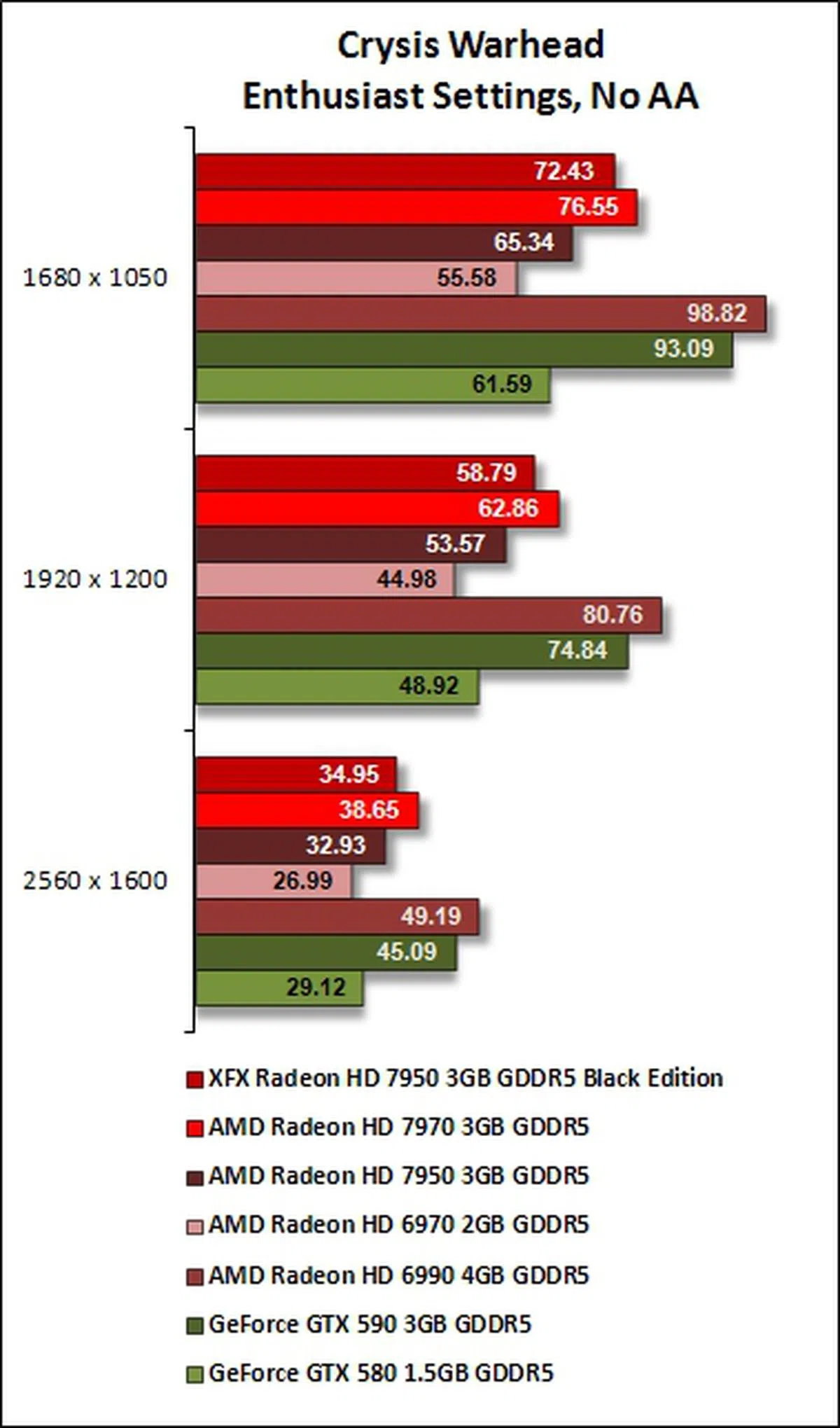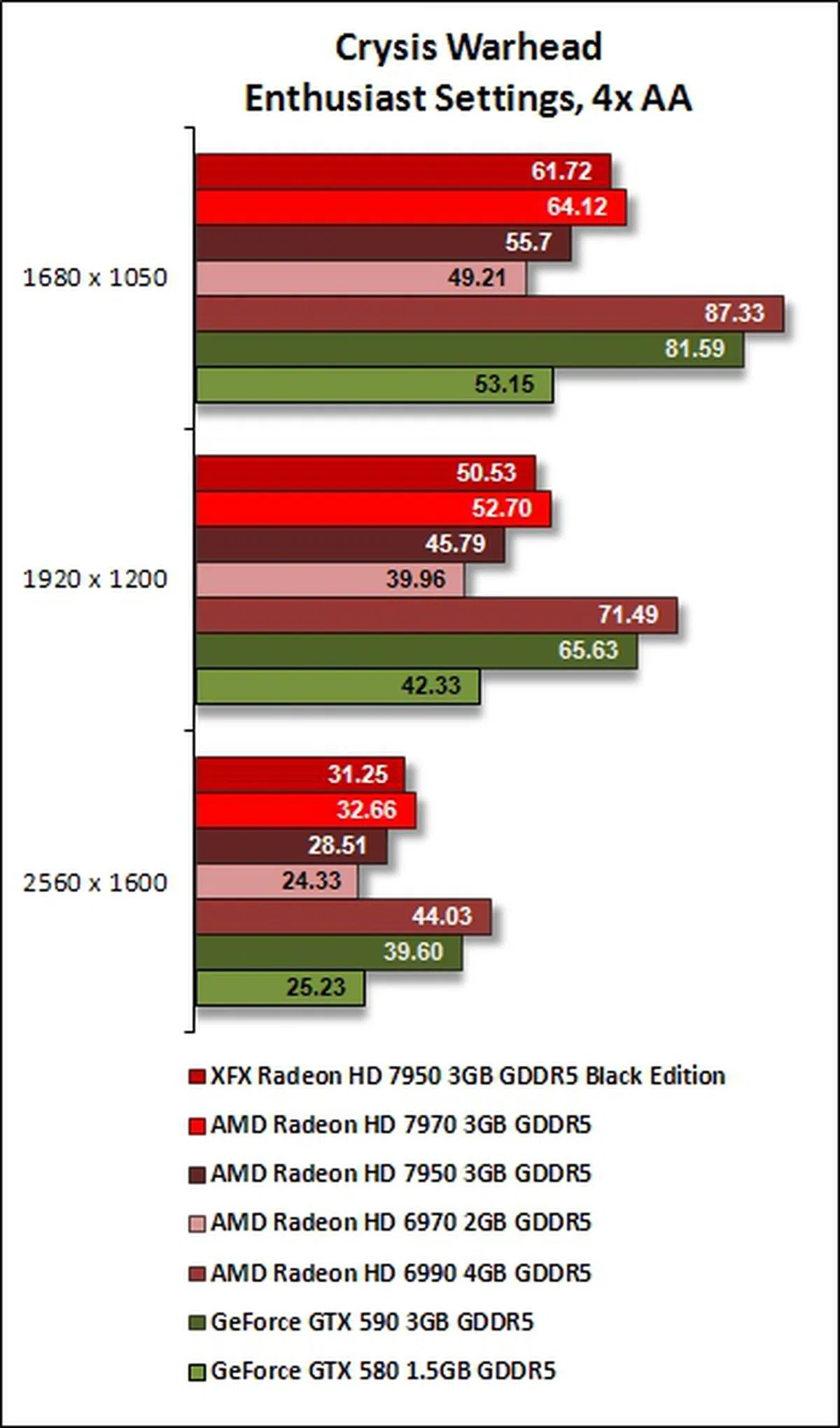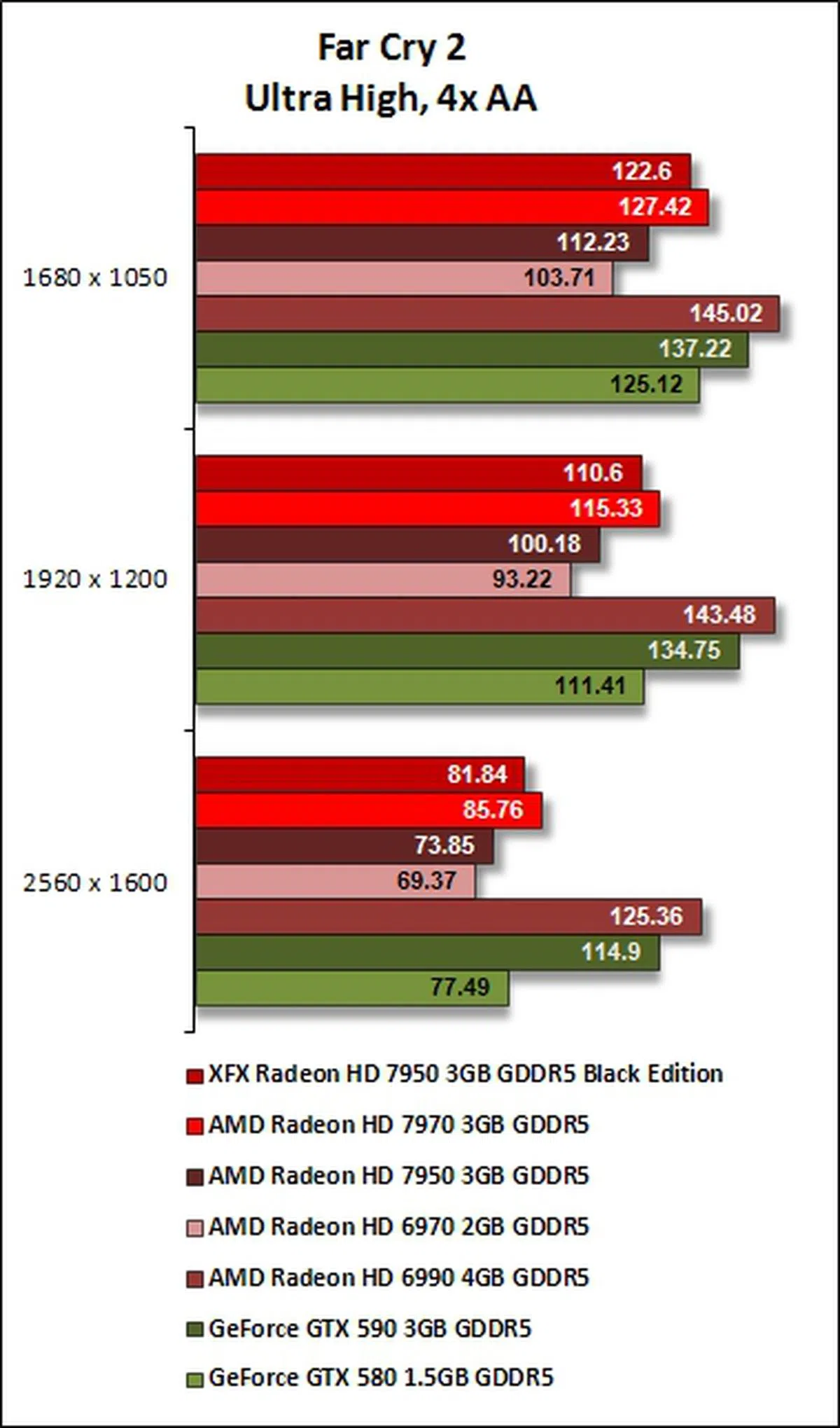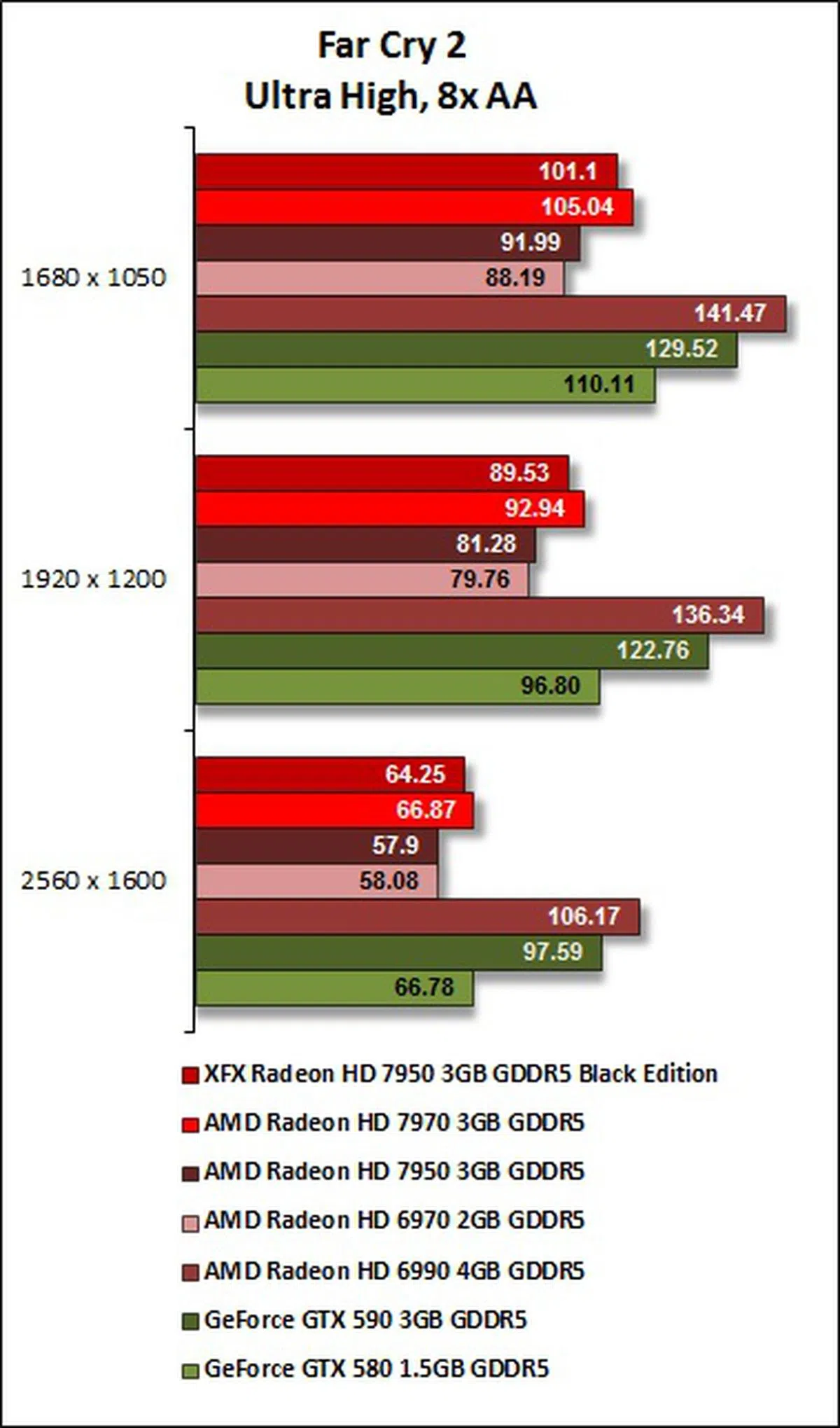XFX R7950 Black Edition Double Dissipation - A Performance Thoroughbred
The XFX R7950 Black Edition Double Dissipation graphics card features an overclocked Tahiti Pro GPU core, custom PCB with quality components and a custom dust-proof cooler. With performance beyond our expectations and at a reasonable price, this card should be high on your upgrading list.
By Wong Chung Wee -
Walking the Middle Ground with the 7950
Exactly a month ago, we witnessed AMD offering a fairly big performance leap for gaming enthusiasts with the availability of the Radeon HD 7900 series. Currently occupying the throne for the most powerful consumer graphics cards with the Radeon HD 7970 and the Radeon HD 7950, it remains to be seen if they'll hold their spot with the onset of the NVIDIA GeForce GTX 680. We'll find out in a week's time, but for now, we focus upon an overclocked Radeon HD 7950 offering from graphics card specialist XFX.
As covered in our detailed Radeon HD 7900 series article, the Radeon HD 7950 offers enthusiasts a pretty good upgrade option if you're not already using some of the top previous generation graphics cards (Radeon HD 6970 and GeForce GTX 580 to name a few). It shares the same Tahiti GPU core as the AMD Radeon HD 7970, but has less active GCN compute units (28 to be exact). As with most other GPU offerings that play second fiddle to the fastest SKU, the target market for the Radoen HD 7950 are enthusiasts looking for premium performance of the Taihiti GPU at a slightly discounted price. Using the launch prices of the Radeon HD 7900 series, the 7950 is a notable 18% cheaper than its speedier counterpart. To get a better picture of where the AMD Radeon HD 7950 stands, do check out the specifications comparison table.

The XFX R7950 Black Edition Double Dissipation has its Tahiti Pro GPU overclocked by 100MHz to 900MHz. Its 3GB of GDDR5 video memory is rated at 5500MHz, an increase of 500MHz from the factory default rate of 5000MHz.
Once You Go Black, You Can't Go Back!
The XFX R7950 Black Edition Double Dissipation is one of the earlier Tahiti Pro GPU based cards to reach our office. Measuring close to 27cm in length, it's identically sized to the reference Radeon HD 7950 and the last generation Radeon HD 6900 series. As its name suggests, it is XFX's top model which is massively overclocked; in fact it has clocks that rival that of the Radeon HD 7970. The XFX R7950 Black Edition has its GPU overclocked by 100MHz to 900MHz and its video memory is rated at 5500MHz, an increase of 500MHz from the factory default rate of 5000MHz. Considering that a Radeon HD 7970 reference graphics card is rated at 925MHz for its GPU and 5500MHz for the memory, it would seem that the XFX card can come close to rivaling it. But don't forget that the Radeon HD 7950 GPU has only 28 Compute Units (CU) versus 32 on the more powerful 7970 model. This disparity means there is a total of 1792 stream processing units active instead of 2048 and that would definitely add up to performance differences.
In this review of the XFX card, we'll find out just how much better is it over a standard Radeon HD 7950 graphics card and how close (or far) is it from a more pricey Radeon HD 7970 graphics card. Given the XFX R7950 Black Edition Double Dissipation card's similar clock speeds to a 7970 GPU model, it would also be interesting to see how the latter's four more CU engines contribute to overall performance (and one more render back end unit).

The XFX R7950 Black Edition features the AMD standard port configuration of one Dual-link DVI, one HDMI port and two mini DisplayPorts. Notice the XFX insignia of the metal bracket? It adds a pleasant aesthetic touch to the card, breaking the monotony of the linear ventilation ports.
Even though the same reference cooler serves the needs well for both the 7970 and the 7950 GPU models, XFX opted to equip its R7950 Black Edition Double Dissipation with a better cooler to help overclockers get more out of the card. Its cooler design consists of dual 40mm fans blowing over its large radiator heatsink. The entire heatsink is encased by a metallic shroud that gives the card a sleek and streamline facade. XFX has named its special cooling solution "Double Dissipation" and the fans are supposedly dust-proof, ensuring their optimal performance when cooling the heatsink.

The sleek aluminum housing of the twin 40mm fans, removed from the PCB of the card.

The back of the heatsink that is housed within the twin-fan casing. In order to remove the heatsink from the fan housing, we had to remove a total of 19 screws! This task would entail a lot of elbow grease, but only if you intend to do some modifications of your own. Besides cooling the AMD Radeon HD 7950 GPU, there are a number of thermal pads that play an important part to cool the memory chips and MOSFETs on the PCB of the graphics card.
Beneath the Double Dissipation Heatsink
Before getting down to performance matters, here's a few more shots of the bare card. Removing the heatsink of the XFX R7950 Black Edition Double Dissipation, we were met with its black PCB (which XFX claims it has 2oz of copper). On its top right hand corner of the card are the two six-pin power connectors. We were half expecting one of them to be an 8-pin power connector which would have allowed the board to have had an increase in power intake if required for more extreme overclocking. In any case, we'll check out how it fares in our overclocking trials soon enough. Back to power matters, XFX recommends using the card with a PSU that's rated at least 500W to run it on your rig. We suggest using a PSU rated 750W and above if you're thinking of setting up a multi-GPU CrossFireX solution.

The PCB of the XFX R7950 Black Edition Double Dissipation graphics card features 2oz of copper, solid capacitors and ferrite core chokers.There are also a total of twelve memory chips surrounding the Tahiti Pro GPU.

A closeup of the Hynix memory chips reveals its model number - H5GQ2H24MFA. A search on the web showed that the same chips are featured on a number of Cayman GPU-based (Radeon HD 6900 series) graphics cards.

The card sports a CHiL voltage controller, together with its collection of solid capacitors and ferrite cores, make up the VRM solution.
Prior to separating the cooling solution from the PCB of the card, we observed that the heatsink didn't seem to sit properly above a few of the memory chips. Normally we wouldn't be concerned much as the thermal pads act as a decent interface material, but on this card, we saw a couple of memory chips peeking out and not covered by the heatsink nor the thermal pads. For the perfectionists, you may have concerns when the card is used for an extended period of time, but we didn't encounter any in our trials. In any case, we wouldn't be too concerned about it and it's more of an observation we're passing on. To be safe, you might want to avoid overclocking the memory further.

The two Hynix memory chips near the PCIe interface of the card are not fully covered by the heatsink, nor the thermal pads.
Test Setup
As usual, the following are the specs of our trusty graphics card test bed system:-
- Intel Core i7-975 (3.33GHz)
- Gigabyte GA-EX58-UD4P motherboard
- 3 x 1GB DDR3-1333 G.Skill memory in triple channel mode
- Seagate 7200.10 200GB SATA hard drive
- Windows 7 Ultimate 64-bit
With reference to our earlier article on the AMD Radeon HD 7900 series, we are recalling the same set of cards for comparison against the XFX R7950 Black Edition to see how this overclocked card stands out against the competition.
The list of card tested and driver versions used:
- XFX R7950 Black Edition Double Dissipation 3GB GDDR5 (AMD Catalyst 12.2 Preview Version)
- AMD Radeon HD 7970 3GB GDDR5 (AMD Catalyst 12.2 Preview Version)
- AMD Radeon HD 7950 3GB GDDR5 (AMD Catalyst 12.2 Preview Version)
- AMD Radeon HD 6990 4GB GDDR5 (AMD Catalyst 11.11)
- AMD Radeon HD 6970 2GB GDDR5 (AMD Catalyst 11.11)
- NVIDIA GeForce GTX 590 3GB GDDR5 (ForceWare 285.62)
- NVIDIA GeForce GTX 580 1560MB GDDR5 (ForceWare 280.26)
The extra card that was used power and temperature comparison:
- Sparkle Calibre X580 1560MB GDDR5 (ForceWare 280.26)
Note that we've excluded Unigine v2.1 and S.T.A.L.K.E.R. in this round of testing as we've already established how the various GPUs scale in these time consuming tests. Instead, we focus on XFX R7950 Black Edition's performance in our gaming benchmarks. We are also paying attention to its temperature, power and overclocking prowess when the card is put under duress.
The list of benchmarks used:
- Futuremark 3DMark 11
- Crysis Warhead
- Far Cry 2
- Crysis 2
- Batman: Arkam City
- Dirt 3
3DMark 11 Results
As an overclocked card, we expect the XFX R7950 Black Edition Double Dissipation to perform better than the stock AMD Radeon HD 7950 graphics card, in light of the slew of various DirectX 11 functions such as tessellation and DirectCompute used by 3DMark 11 benchmarking utility. With that said, the XFX R7950 managed to secure gains in the range of over 9% to approximately 11% over the Radeon HD 7950. The performance increase in this benchmark was almost proportional to the percentage increase in its clock speeds over a reference card. It narrowed its losing margin against Radeon HD 7970 to slightly over 5% (versus the losing margin of almost 20% for the standard Radeon HD 7950) on the Extreme preset.
Understandably, the XFX R7950 was clearly outclassed by the dual-GPU cards from both NVIDIA and AMD but it managed to put itself well ahead of last year's single GPU graphics card king, the NVIDIA GeForce GTX 580.

Battlefield Bad Company 2 Results
From our early experience with the AMD Radeon HD 7900 series graphics cards, they seem to be a bit weak in the area of tessellation. This disadvantage is clearly evident from our benchmark scores below. The XFX R7950 failed to beat its main competitor, the NVIDIA Geforce GTX 580, but it did improve upon the reference Radeon HD 7950 notably and was rather close to challenging the NVIDIA counterpart.

Crysis Warhead
The common nugget of information garnered from observation of both graphs is the fact XFX R7950 Black Edition is beaten by its more expensive counterpart, the AMD Radeon HD 7970. Compared to it, the XFX R7950 was again edged out by margins in the range of roughly 5 to 7%. This is consistent to earlier test results.
 |  |
Far Cry 2
For this benchmark, NVIDIA GeForce cards usually do well and we see the Geforce GTX 580 being added as a strong rival for the AMD graphics cards. Still, the XFX R7950 Black Edition put up a good fight and was hardly much slower than it and the the Radeon HD 7970.
 |  |
Crysis 2 Results
Even in its overclocked state and at the lowest resolution used in the benchmark test, the XFX R7950 Black Edition graphics card failed to cross the 30fps mark.

Batman: Arkham City Results
The performance scores of all the Southern Island cards were consistent regardless of the resolution settings, which is quite puzzling. At the highest resolution of 2560 x 1600, the XFX R7950 Black Edition only managed to generate a paltry score of 27fps. It was no match for the GeForce cards which so far have had a track record at tackling DX 11 games better. Additionally, do note that this is a PhysX optimized games which naturally fare better on NVIDIA cards.

Dirt3 Results
We have excluded testing the cards with the benchmark at 8x MSAA setting as in our earlier testing efforts, the beta drivers failed to support the Southern Island cards at that setting. The XFX R7950 Black Edition is almost neck-to-neck with AMD Radeon HD 7970; it also eked out gains in the range of roughly 1% to about 10% over NVIDIA Geforce GTX 580.

Temperature
The Radeon HD 7970 recorded the second highest temperature of 72 degrees Celsius while XFX R7950 Black Edition Double Dissipation operates at a cool 54 degrees Celsius. Looks like the custom cooler is doing a great job. Our earlier misgivings with regards to the ill-aligned heatsink over the card's memory chips are somewhat alleviated with the good showing of the card on this test. Out of curiosity, we measured its temperature again when we overclocked the XFX card and its temperature was yet maintained at just 54 degrees Celsius!

Power Consumption
The power consumption of XFX R7950 Black Edition is even lower than the stock AMD Radeon HD 7950. We were quite impressed because the outcome reinforces XFX's dedication in selecting some of the best GPU dies along with quality components (which they term as Duratec) used on the board. The combination of this really shows with performance close to the Radeon HD 7970 and yet sipping power less than the reference Radeon HD 7950 graphics card. Not to mention, it's also a lot more power efficient than the NVIDIA GeForce GTX 580.

Overclocking
We managed to push the clock speed of the card's Tahiti Pro GPU to 1060MHz, an approximate increment of 17% over its factory OC rate of 900MHz. For its memory system, we managed to overclock it to 5880MHz, a gain of about 1.4% over its orginal value of 5800MHz. This was achieved by pushing the card's operating voltage from 1.031V to 1.093V. In its user overclocked state, the XFX R7950 Black Edition is the fastest single-GPU graphics card!

Excellent Performance with Boundless Potential
It is clear as crystal by this juncture that AMD is targeting NVIDIA's top GeForce GTX 580 single GPU offering with the Radeon HD 7950. From our performance tests, the XFX R7950 Black Edition Double Dissipation had its fair share of wins against the NVIDIA GeForce GTX 580 and was on the heels of its speedier brethren, the AMD Radeon HD 7970. We are generally impressed with this variant of Radeon HD 7950 by XFX.
As we take a closer look at the card's other characteristics in terms of its power consumption and operating temperature, XFX's Double Dissipation cooling technology seems effective in keeping its operating temperature well in check. This was especially evident when we were overclocked the card. We also noticed that the pair of 40mm fans spun away quietly when compared to the closed vapor cooling chamber of the stock AMD Radeon HD 7900 series of graphics cards. Also impressive was the card's power management as it consumed even lower power than the reference Radeon HD 7950 (in-line with what XFX promised), while providing performance that rivaled the Radeon HD 7970.

The XFX R7950 Back Edition Double Dissipation came in a retail package that was smaller in stature when compared to the usual larger boxes we were accustomed with. As the saying goes, good things tend to come in small packages and it resonates well with the XFX R7950's performance and overclocking potential.
The XFX R7950 Black Edition Double Dissipation card is quite competitively priced at roughly S$680 while its NVIDIA counterpart, i.e., GeForce GTX 580 based cards still retail at about S$750. Given the test results we've shared, the XFX card is a far more compelling option. Of course, the only advantage NVIDIA has is its 3D Vision kit to easily adopt 3D gaming. That's not to say AMD's solution aren't able to game in 3D, but it is more difficult to source for accompanying software and hardware to get it going.
Apart from the point of 3D gaming, it is clear that XFX has a winner in their hands here. Other competing Radeon HD 7950 solution are also as competitively priced, but with its outstanding performance and overclocking potential, the XFX R7950 Black Edition Double Dissipation is a top contender in the retail market for top-tier graphics cards. In additional to its support for multi-monitor gaming possible via EyeFinity 2.0 on just a single GPU (unlike the GTX 580), it makes it all the more compelling as a sound purchase decision for graphics card upgraders.
If you've set your mind to go get one, take careful note when you're at the retail shops as XFX has four variants of their R7950 graphics cards. They have a standard model with a more basic cooler and non overclocked components. Then there are two versions of the Black Edition, where one is the Double Dissipation version and the other is using a more basic cooler. There's even a standard clocked model with a Double Dissipation cooler! So just be sure what you end up buying. The version reviewed here is the best of the group, which is a Black Edition Double Dissipation card. Phew, what a mouthful!
Our articles may contain affiliate links. If you buy through these links, we may earn a small commission.